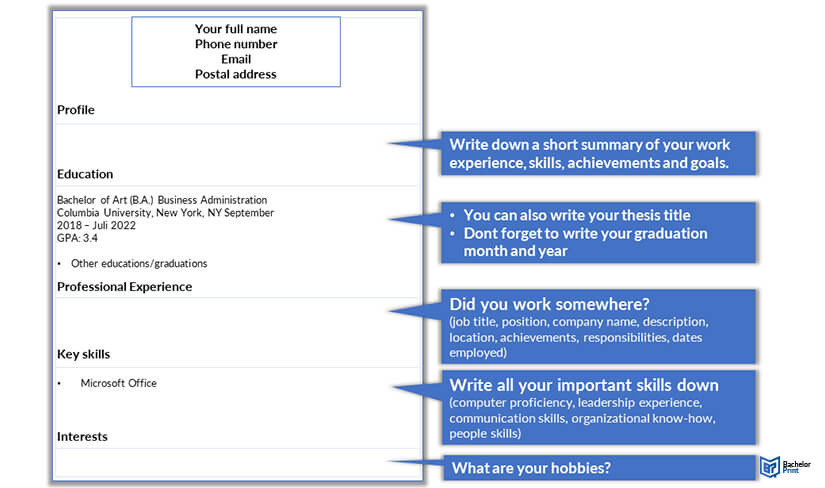
Are you applying to join a selective post-graduate course? You’ll need to submit a graduate school resume. Providing a graduate CV allows examiners to consider what lies beyond your raw grades. Knowing exactly how to create an articulate and attractive resume that showcases and promotes your academic background, research experience, work history, skills, and accomplishments. Unlike a typical job-oriented resume, this version places a stronger emphasis on academic achievements. Learn more in this article.
Definition: Graduate school resume
A post-graduate course is any tought scheme that requires a completed undergraduate diploma (e.g., BA, BSc, Foundation Award or equivalent) for admission. All successful post-graduate applications require the submission of a resume with a personal statement, proof of completion and proficiency (e.g., a certificate), module grade transcript(s), and (if appropriate) a basic research proposal.
A verifiable academic CV gives strong credibility to any claims you make in your paperwork. It also highlights any relevant boons gained from (paid) work, hobbies, short courses, life experience, or your pre-university awards (e.g., GCSEs, A Levels).
You may have written a professional CV to apply for jobs before. If so – great! An academic graduate resume is very similar in layout, content, and tone.
However, the recommended information for graduate resumes is slightly different. An effective academic resume focuses more on your future learning potential and transferable skills than your objective past.
A graduate resume always contains the following information:
- Your full name
- Your public contact details (e.g., Phone, email, postal address)
- Any reference codes
- A short statement of application
- Your education
- Your work experience (if relevant)
- Your skills
- Your interests

Printing Your Thesis With BachelorPrint
- High-quality bindings with customizable embossing
- 3D live preview to check your work before ordering
- Free express delivery
Configure your binding now!
Step 1: Graduate school resume layout
The first step is to set out a style template. Clear, consistent, sensible formatting keeps your resume clean, readable, and attractive.
Pick a well-known and easy-to-read font (e.g., Times New Roman, Black) and sizing (e.g., 14 pt.) for your paragraphs, main heading, and subheadings. Avoid suddenly changing the font type, color, or size between sections.
Unreadable or awkward formatting instantly puts people in a bad mood. Always avoid using “pet hate” fonts (e.g., Courier, Papyrus, Comic Sans) and garish colors wherever possible. If your resume contains page breaks, bullet points, or colored highlights? Ensure those stay consistent, too.
Different post-graduate courses will privilege select elements of your resume. STEM courses tend to value attendance, concrete achievements, and grades. Arts (and business) appreciate evidence of soft skills, successful projects, and portfolio work.
Read the assessment criteria for each course carefully. Fine-tuning your work between different applications is good practice.
Example of a graduate resume layout

Step 2: Graduate school resume heading
The heading section introduces who you are and your reasons for applying. The sub-heading also handily lists your contact details.
You should order your heading as below:
- Write your full name
- Your public contact information (e.g., Phone, post, email)
- A brief summary of your undergraduate course(s) and achievements
- A sentence about your application
- Your referees (if applicable)
Successful (university-level) graduates should use the past tense and state their last course completion date. Current undergraduates should use the present tense and their scheduled finishing date.
| Do | Don't |
| • Use a big, bold banner font to state your name • Use sensible, attractive header graphics in neutral colors • Briefly describe your last employer (if relevant) |
• Include your social media links (e.g. LinkedIn, Facebook) • Use too much detail - Plenty of room below! • Pick an inappropriate or immature email address |
Step 3: Education on the graduate school resume
The next step is to list the academic institutions you attended and what you gained from them. You can list universities, colleges, and schools.
Institutions should list in reverse chronological order (i.e., most recent first). Each entry should start with a sub-heading stating each institution’s name, your taught course, and your attendance period.
You should quickly detail your research interests, achievements, and general (academic) experiences below each in bullet points or a prose sentence. You should also state your final grade(s) as a bold sub-heading (e.g., First Class Honors).
The key to creating a convincing educational section is to prune your entries to keep them focused, positive, and relevant. Any performance too old, irrelevant, disappointing, niche, or short to impress should go.
Awards and Honors
Have you covered everything worthwhile? You can always add another sub-section underneath for extra awards.
State any exceptional attainment (e.g., letters of merit, league table placings, media appearances, medals and trophies, athletic certificates) otherwise missed here. Don’t repeat your taught course grades.
Step 4: Work on the graduate school resume
Next, describe any relevant professional experience you’ve gained in much the same way, listed again in reverse-chronological order. You can include paid positions, voluntary positions, internships, and commissions.
If your outside work wasn’t precisely relevant to your chosen course, try to highlight any transferable skills (e.g., timekeeping, self-discipline, attention to detail) it taught you. Again, prioritize the most impressive, recent, prestigious, and relevant places of work.
| Do | Don't |
| • Clearly state any formal certification(s) (e.g. NVQs) gained • Mention any informal awards Won (e.g. Employee of the Year) • Demonstrate a well-rounded and caring life beyond academia |
• Include periods of work lasting under six months (Unless exceptional) • Pad your resume - Stick to major, recent roles instead • Lie or exaggerate - Examiners check! |
Step 5: Skills on the graduate school resume
Your final step should be to systematically list anything of merit left that didn’t fit elsewhere. You can include anything you’ve published, your language certification(s), and any interests and hobbies.
Publications and presentations
If you’ve had your academic work published, include a reference (in an established style e.g. Chicago style) to each piece.
Languages and Technical Skills
Some universities and courses may require you to prove competency in a particular language (e.g., English, French, German) before accepting your application.
If you haven’t completed an undergraduate degree in the language requested, include your proof of proficiency credentials (e.g., a CEQ C2 Certification). State your invigilator and the date of the award, too.
You can also include technical skills. If you’re applying to anything involving computer science, it’s a great space to list your known programming languages (e.g., HTML) and software experience. More general applicants might benefit from discussing their experience in management, analysis, and project coordination.
Extracurricular activities
It’s up to you what you disclose about your personal life on your CV. However, it’s often worth putting together a brief overview of your public profile. Showing a range of engaging interests can also help add depth and charisma.
Proofread and save your graduate school resume
Once you’ve finished your first draft, read it back to catch and change any errors and redundancies. Your resume’s accuracy, clarity, completeness, and “polish” all count.
Double-check the following:
- Spelling, tone, and grammar – Use checkers
- Layout, overrun, and formatting – Avoid breaks, shrinking, and stretching
- Succinctness – Is anything irrelevant?
- Tautologies – Avoid repetition
- Completeness – Have you missed anything vital?
- Veracity – Can your claims be reliably evidenced? If not, why?
- Style – Is it consistent and presentable?
Once you’re happy, save your finished work by exporting it as a PDF file. Using PDF prevents most compatibility and upload issues, keeping your resume readable. You can also print a paper copy for reference.
FAQs
Try to limit your document to two sides of A4. Use bullet point lists to reduce sprawl.
No. Although you should definitely mention your undergraduate degree(s), you’ll also need to submit an independent copy of your formal certificate(s).
Yes – lying, exaggerating, or misrepresenting yourself may result in rejection, censure, or (later) expulsion. Examiners will account for your age, any life setbacks, and the intensity of your undergraduate course.
